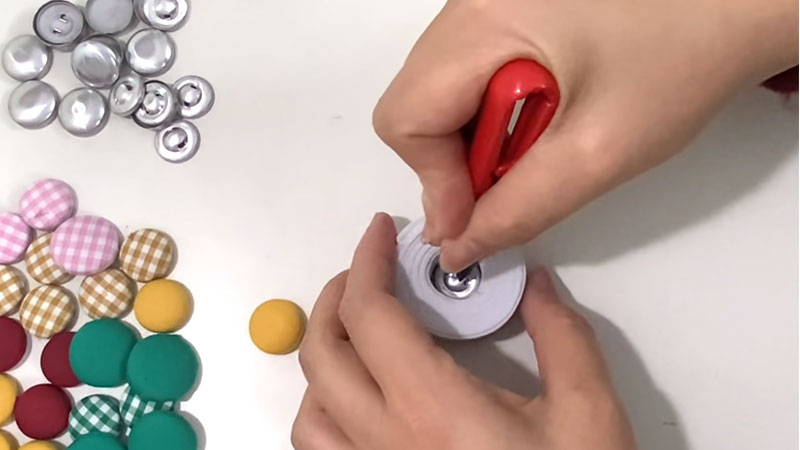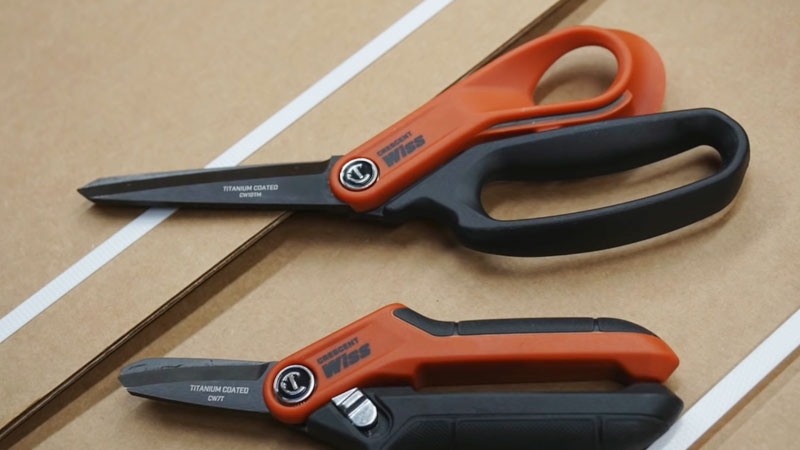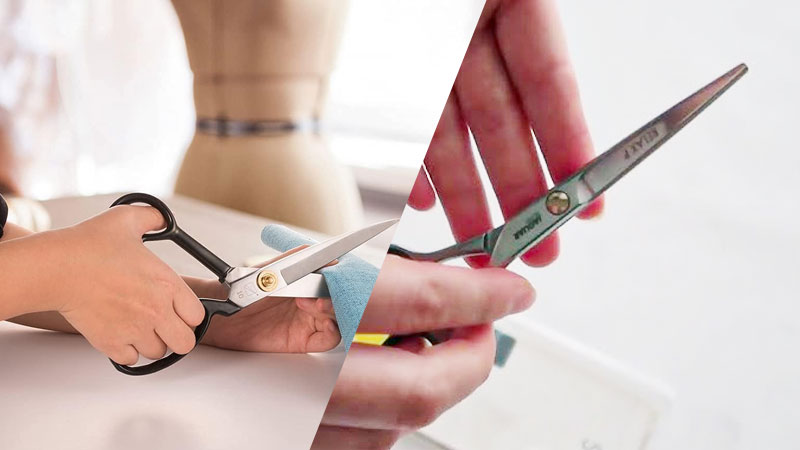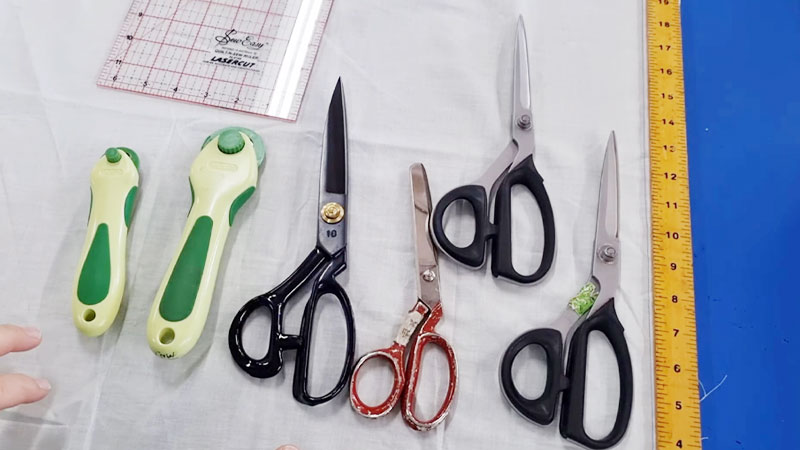The choice of tools in any crafting or DIY project is pivotal to achieving the desired outcome. One common dilemma that arises is whether it’s acceptable to use sewing scissors for cutting rubber materials.
While sewing scissors are designed for precise fabric work, they may encounter limitations when faced with rubber.
This introductory exploration delves into the feasibility and practicality of using sewing scissors to cut rubber, weighing the pros and cons, discussing potential implications on the tool’s longevity, and providing tips for safer and more efficient rubber cutting.
By the end, you’ll have a clearer understanding of when it’s okay to rely on sewing scissors and when alternative tools are more suitable for the task.

Is It OK to Use Sewing Scissors to Cut Rubber?
Using sewing scissors to cut rubber can be acceptable in certain situations, but it’s important to consider a few factors before doing so.
Sewing scissors are designed primarily for cutting fabric and threads, and while they can cut through rubber, there are some limitations and potential drawbacks to keep in mind:
Material Thickness
Sewing scissors are typically designed for thin and flexible materials like fabric. If you’re trying to cut thick or heavy rubber, such as a rubber sheet or tire, sewing scissors may not be up to the task. Attempting to cut thick rubber could damage the scissors or cause them to become dull.
Blade Material
The blades of sewing scissors are usually made of stainless steel or other non-corrosive materials.
Rubber can be abrasive and may cause faster wear and tear on the scissors’ blades. This could reduce their effectiveness for cutting fabric in the long run.
Clean Cuts
Rubber tends to be more difficult to cut cleanly compared to fabric. When using sewing scissors on rubber, you may encounter jagged edges or uneven cuts. This can be a problem if you need precise and clean cuts for your project.
Safety
Cutting rubber with sewing scissors may require more effort, and there’s a risk of the rubber slipping or the scissors becoming jammed. This could lead to accidents or injuries, so it’s important to exercise caution.
Scissor Damage
Cutting rubber can dull the scissors’ blades relatively quickly. If you frequently use sewing scissors for cutting rubber, you may need to sharpen or replace them more often, which can be an added expense.
Best Scissors for Cutting Rubber

When it comes to cutting rubber, especially thicker or tougher rubber materials, it’s important to use the right type of scissors or shears to achieve clean, precise cuts without damaging the tool or compromising safety.
Here are some of the best types of scissors or shears for cutting rubber:
Heavy-duty shears or Scissors
Heavy-duty scissors or shears are designed for cutting tough materials, making them an excellent choice for cutting rubber.
Look for scissors with serrated or non-stick blades to prevent the rubber from sticking to the blades during cutting.
Utility Shears
Utility shears, also known as utility scissors or heavy-duty utility knives, are versatile tools that can handle a variety of cutting tasks, including rubber. They often have sharp, serrated blades designed for cutting through tough materials.
Industrial Shears
Industrial shears are specifically designed for heavy-duty cutting tasks and are suitable for thick rubber materials. They have robust blades that can withstand the stress of cutting rubber.
Rubber Shears
Some specialty shears are designed explicitly for cutting rubber. These shears often have extra-sharp blades and ergonomic handles for comfortable use.
Rotary Cutters
Rotary cutters with sharp, circular blades can be effective for cutting rubber, especially for making straight lines or curved cuts in thinner rubber materials.
Electric Scissors
Electric scissors or shears are motorized cutting tools that can handle rubber with ease. They provide consistent cutting power, making them a good choice for large rubber-cutting tasks.
Fabric Scissors vs. Regular Scissors

Fabric scissors and regular scissors serve different purposes and have distinct characteristics. Fabric scissors differ from regular scissors in several key ways, and these differences make them better suited for cutting fabric.
Here are some of the primary distinctions:
Blade Shape and Edge
Fabric scissors typically have longer, thinner blades with a distinct shape that allows for smooth and precise cutting through fabric.
The blades are often tapered to a fine point, which is ideal for making detailed cuts or cutting along curves.
In contrast, regular scissors may have shorter, broader blades with a more general-purpose design.
Serrated or Micro-Serrated Blades
Many fabric scissors feature serrated or micro-serrated blades. These serrations grip the fabric while cutting, preventing slippage and ensuring cleaner cuts. Regular scissors usually have smooth blades that may not grip fabric as effectively.
Sharpness
Fabric scissors are designed to stay sharp for longer periods, even when cutting through various fabric types. Regular scissors may lose their sharpness more quickly when used on fabric, resulting in frayed edges.
Ergonomics
Fabric scissors often have ergonomic handles with comfortable grips designed for prolonged use. They minimize hand fatigue and strain during extended cutting sessions. Regular scissors may not prioritize ergonomic features to the same extent.
Specialization
Fabric scissors are specialized tools for cutting fabric and are typically not used for cutting paper, cardboard, or other materials. Regular scissors are designed for a broader range of cutting tasks.
Maintenance
Fabric scissors should be used exclusively for cutting fabric to maintain their sharpness. Regular scissors can be used for a variety of tasks without the same level of maintenance concern.
Durability
Fabric scissors are crafted to withstand the demands of fabric cutting, which can include cutting through multiple layers of thick fabric or heavy materials like denim. Regular scissors may not be as durable when used for these purposes.
Clean Cuts
Fabric scissors are known for producing clean, neat cuts in fabric without fraying or damaging the material.
Regular scissors may produce less clean cuts on fabric, especially if they are not specifically designed for this purpose.
Here is how do fabric scissors differ from regular scissors:
| Aspect | Fabric Scissors | Regular Scissors |
| Blade Shape | Longer, thinner blades with a fine point and tapered edge for precision cutting | Shorter, broader blades with a more general-purpose design |
| Blade Edge | Often serrated or micro-serrated to grip fabric and prevent slippage | Smooth blades for general cutting tasks |
| Sharpness | Designed to stay sharp when cutting fabric for extended periods | May lose sharpness more quickly when used on fabric |
| Ergonomics | Often feature ergonomic handles for comfortable, prolonged use | May have basic handles without ergonomic features |
| Specialization | Specialized for cutting fabric and not typically used for other materials | Designed for a broader range of cutting tasks |
| Maintenance | Should be used exclusively for cutting fabric to maintain sharpness | Can be used for various tasks without specific maintenance concerns |
| Durability | Often serrated or micro-serrated to grip the fabric and prevent slippage | May not be as durable for heavy fabric cutting |
| Clean Cuts | Known for producing clean, neat cuts in fabric without fraying or damage | May produce less clean cuts on fabric, especially if not designed for it |
Can You Use Regular Scissors to Cut Fabric

Yes, you can use regular scissors to cut fabric, but the quality and type of scissors you use can significantly affect the ease and precision of your cutting.
Regular scissors come in various styles and sizes, so it’s important to choose the right pair for cutting fabric to achieve clean, accurate cuts.
Here are some tips for using regular scissors to cut fabric effectively:
Sharpness
Ensure that your regular scissors are sharp. Dull scissors can lead to frayed edges and uneven cuts. If your scissors are not sharp, consider sharpening them using a sharpening tool or having them professionally sharpened.
Fabric Type
Different fabrics may require different types of scissors. For lightweight and delicate fabrics like silk or chiffon, choose fine, sharp scissors.
For heavier fabrics like denim or upholstery material, opt for heavier-duty scissors that can handle the thickness.
Size
The size of your scissors matters. For intricate or detailed cutting, smaller scissors with fine tips can be useful. Larger scissors with longer blades are better for cutting long, straight lines.
Handle Comfort
Comfortable handles are essential, especially if you plan to cut a lot of fabric. Ergonomically designed scissors can reduce hand fatigue during extended cutting sessions.
Cutting Technique
When cutting fabric, open and close the scissors smoothly in a continuous motion. Avoid pushing or forcing the scissors through the fabric, as this can lead to jagged edges or snags.
Proper Maintenance
Regularly clean and maintain your scissors by wiping them clean after use and storing them in a safe place. This helps prevent rust and keeps the blades sharp.
FAQS
Can sewing scissors be used for thin rubber sheets?
Yes, sewing scissors can often cut thin rubber sheets effectively. However, it’s still important to ensure the scissors are sharp and to exercise caution during cutting to achieve clean results.
Are there any safety precautions when using sewing scissors on rubber?
Yes, always wear appropriate safety gear, including eye protection and gloves, when cutting rubber with sewing scissors. This minimizes the risk of accidents and injuries.
Can I use regular household scissors for rubber cutting in a pinch?
Regular household scissors can be used for cutting rubber in a pinch, especially for thin or flexible rubber.
What types of rubber are most suitable for sewing scissors?
Sewing scissors are best suited for cutting soft and pliable rubber materials, such as rubber bands, gaskets, or thin rubber sheets. For thicker or tougher rubber, consider alternative cutting tools.
How can I prolong the lifespan of sewing scissors when using them for rubber cutting?
To extend the life of your sewing scissors when cutting rubber, avoid using excessive force, keep them clean and dry, and periodically sharpen the blades.
To Recap
while it is possible to use sewing scissors to cut rubber, it should be approached with caution and consideration of the type and thickness of the rubber material.
Sewing scissors, designed primarily for fabric, may struggle with thicker or tougher rubber, potentially causing damage to the scissors or producing less-than-ideal results.
Safety precautions, such as wearing protective gear, are essential when using sewing scissors for rubber cutting to mitigate potential risks.
To ensure cleaner, more efficient cuts and extend the life of your sewing scissors, it is advisable to reserve them for fabric-related tasks and invest in dedicated rubber-cutting tools when working extensively with rubber materials.
Leave a Reply